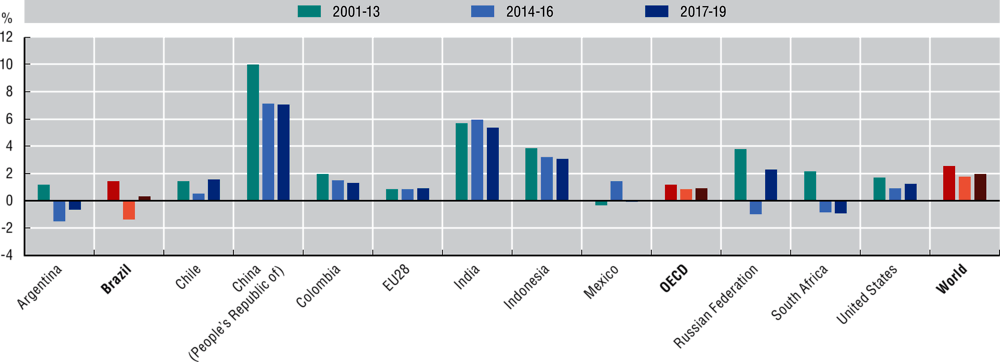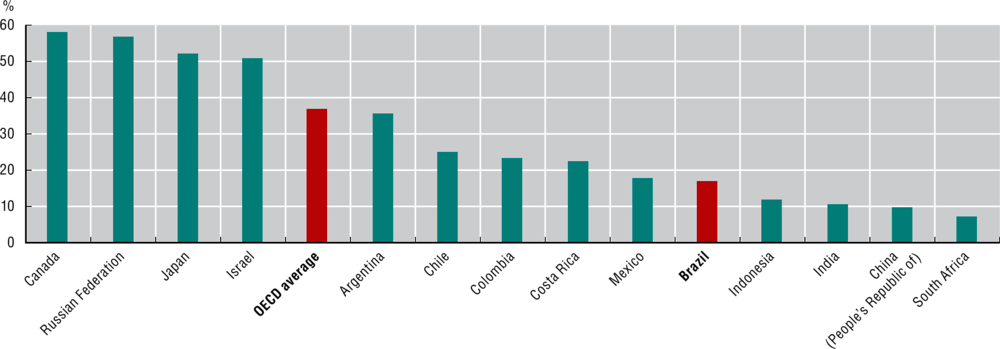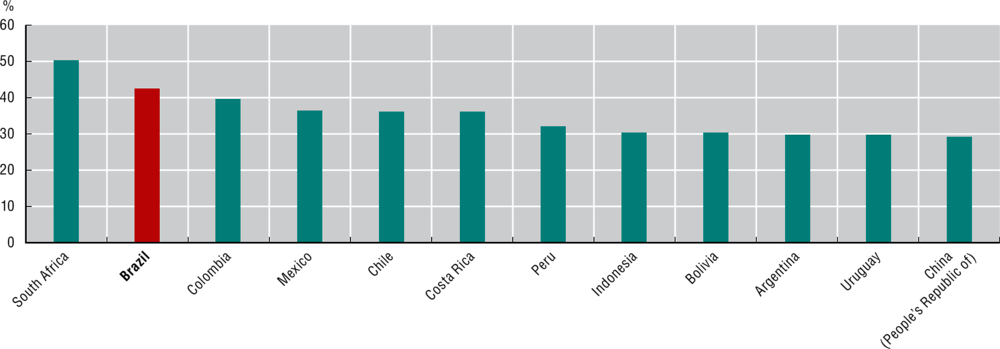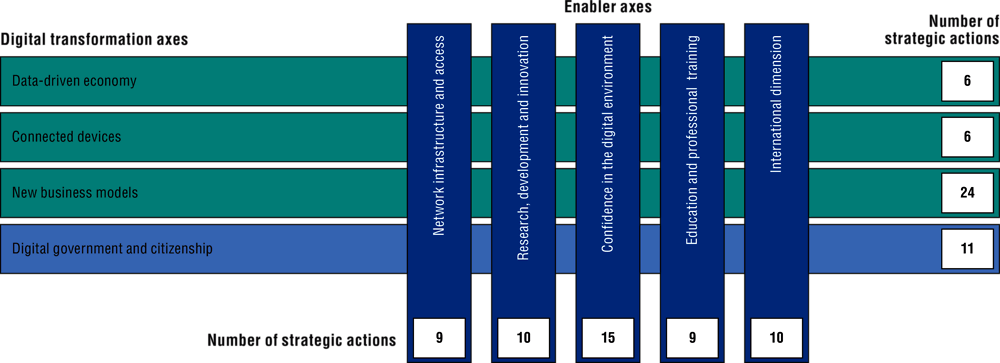This chapter sets the scene for the Review. It begins with an overview of the recent economic and social trends in Brazil and the opportunities the digital transformation could provide in improving the life and well-being of citizens. It then presents the current government response, focusing on Brazil’s E-Digital Strategy. Next, it introduces the OECD Going Digital Integrated Policy Framework. The final section presents an outline of the Review.
Going Digital in Brazil

Chapter 1. Brazil in the digital transformation: Opportunities and challenges
Recent economic and social trends in Brazil
From the turn of the century until the recession in 2014-16, Brazil combined fast economic growth and remarkable social progress. Between 2001 and 2013, real gross domestic product (GDP) grew by 3.5% a year on average, a rate much higher than in the OECD (1.9%), though lower than in Chile (4.5%) and the other BRIICS (Brazil, the Russian Federation, India, Indonesia, China and South Africa) countries (6.2%). The number of poor – defined as people with less than USD PPP 5.50 per day – was cut in half between 2001 and 2014, falling to 18% of the population. The unemployment rate also fell, from 9.8% in 2003 to 6.5% in 2014.
The severe recession from 2014 to 2016 seems to have put a halt on this virtuous cycle. Following the contraction in GDP (-2.1% a year) over this period, the Brazilian economy grew at a much lower annual rate (1.4%) in the following three years (2017-19). The unemployment rate jumped to 12% in 2018 while the number of poor increased by 7.4 million. Inequality remains high by comparison to the OECD, with the richest 10% of the population receiving 42% of total income. Following the Covid-19 crisis, the economy is projected to contract by 7.4-9.1% in 2020 while unemployment is predicted to reach historic highs (OECD, 2020a).
More fundamentally, the favourable constellation that fuelled growth until the 2014 recession – an increasing labour force coupled with rising commodity prices – now seems to be exhausted. Brazil’s population is ageing rapidly and public expenditure is proving increasingly difficult to finance (OECD, 2018a), resulting in the government launching structural reforms, such as the recent reform of the pension system.
Tackling these issues requires a variety of complementary measures. Among them, policies to enhance digital transformation have a key role to play. Digital technologies are an enabler for innovation and productivity in firms. High-speed broadband networks provide individuals and firms with access to government services and international markets, and can help to reduce inequalities. Digitalisation may help to reduce regulatory burdens and informality. It can also increase the efficiency of public spending, therefore providing more resources for policies. Online educational resources offer new tools for teaching and provide individuals and workers with new opportunities for training and skills upgrading.
At the same time, the digital transformation may exacerbate existing inequalities, in particular between high- and low-skilled individuals, large and small firms, as well as urban and rural regions. Policies are key to ensure that the potential benefits from the digital transformation are shared across the economy and society.
Digital transformation can fuel productivity growth
Between 2001 and 2013, yearly labour productivity growth in Brazil was slightly above the OECD average (1.5% versus 1.2%), but well below that in the other BRIICS countries (5.1%) (Figure 1.1). Brazil’s productivity decreased during the 2014-16 recession (-1.3% a year) but started growing again in 2017-19 (0.4%), albeit at a much slower rate than in the OECD and the other BRIICS countries (0.9% and 3.4%, respectively). By 2019, labour productivity in Brazil was only one-fourth the level it was in the United States. The productivity gap was large also relative to Chile (-34%), Mexico (-30%) and Argentina (-26%).
Figure 1.1. Labour productivity growth in selected countries, 2001-19
Output per employed person, average yearly growth rates

Source: The Conference Board (2019), “Output, labor and labor productivity, 1950-2019 (adjusted version)”, https://www.conference-board.org/data/economydatabase/index.cfm?id=27762 (accessed on 6 May 2020).
Digital technologies have the potential to increase productivity in firms across all economic sectors. Big data and data analytics can help firms better understand their production processes, the needs of their clients and partners, and the overall business environment. Digital technologies can also improve firms’ access to skills and talent, such as through better job recruitment sites and in the outsourcing of key business functions, all of which can help improve their performance. New technologies can also facilitate access to a range of financing instruments. Finally, online platforms can support the productivity of lower tech service firms, for example by providing them with booking facilities and efficient matching algorithms based on consumer review and rating systems (OECD, 2019a).
The Internet of Things (IoT), in particular, has significant potential for process innovations and efficiency gains. Modern sensors make it possible to collect vast amounts of data, which can be processed by smart devices and fed into production decisions. The resulting big data sets can create further benefits, including the integration of new services and service providers into the value chain (OECD, 2017a).
Despite widespread access to the Internet, Brazilian enterprises lag behind those in OECD countries in the use of the Internet and digital technologies, largely as a result of low uptake by small and medium-sized enterprises (SMEs). Advanced manufacturing – the combination of digital technologies, robotics, IoT and data analytics to improve production processes and product quality – is still at an early stage (see Chapter 3).
In June 2019, Brazil launched a National IoT Plan aiming to “foster the implementation of IoT as a sustainable development instrument for the Brazilian society, capable of increasing competitiveness, strengthen national production chains and promote higher quality of life” (Decree 9.854 of 25 June 2019). The plan specifies 75 initiatives, organised along 4 transversal thematic axes. Agribusiness and manufacturing are among the plan’s priority sectors (see Chapter 6).
Improving skills for a digital world
Brazil has made substantial progress over the last decades in facilitating access to education. However, despite the increase in education expenditures and the widespread access to free-of-charge primary and secondary education, educational attainment remains low (Figure 1.2). More than 50% of Brazilians have not attained a secondary education, and 17% did not complete primary education. This is well above the OECD average of 2%. Enrolment in professional training and technical degrees is low, with only 3.8% of secondary students choosing technical courses. Low performance on the OECD’s Programme for International Student Assessment (PISA) suggests a low quality of education as well as large disparities in outcomes depending on the socio-economic background of students.
Figure 1.2. Adult population with a tertiary education, 2018
As a percentage of population aged 25-64

Source: OECD (2019b), OECD Education at a Glance (database), http://dotstat.oecd.org/index.aspx?queryid=93189 (accessed on 6 May 2020).
Low skills prevent Internet users and workers from using digital technologies effectively and from benefiting from them, thus creating a second-level digital divide (OECD, 2019c). A lack of skills is also a significant reason for Brazil’s low productivity levels (OECD, 2018a). Brazilian employers report having difficulties in recruiting technicians, skilled trades and engineers. ICT professionals represent the second largest shortage (OECD, 2018b).
Brazil has put in place an online education programme for capacity building in the IT sector – the Brazil More Digital (Brasil Mais Digital) – directed at young people aged 16-25. It has also created new vocational training opportunities under the umbrella of the Pronatec programme. While progress has been made, high dropout rates suggest that these programmes could be improved so as to better serve training needs and match skills demand. There is also scope for better aligning university curricula to the job profiles in demand in the labour market (OECD, 2017b).
While creating demand for new skills, digital technologies and big data can also help increase the effectiveness of education and training programmes. Analysis of online vacancies provides more timely information on skills demand across small geographic areas. Big data allows tracking and evaluating the labour market outcomes of participants in vocational education and training, thus providing information on how to improve vocational education and training. Collecting and disseminating timely information on line on the performance of higher education institutions, e.g. universities, helps prospective students take informed decisions.
Online courses and other open educational resources can be used to improve the digital skills across a broader share of the population, in particular among elderly people, low-income and low-skilled individuals as well as those living in remote areas. Several countries have taken initiatives to develop digital skills either for the whole population or for targeted groups that Brazil could learn from (see Chapter 3).
Digital transformation offers opportunities for more competitive markets
Competition is key for creating incentives to invest in the most efficient production technologies, to introduce new innovative products and to reach global best practice (Pinheiro, 2013; IEDI, 2014). However, entry barriers, low integration into the global economy and targeted industrial policies have led to low competition in the Brazilian economy (OECD, 2018a).
According to The World Bank Doing Business indicators, Brazil scores 137th out of 190 economies surveyed for the ease of doing business (Figure 1.3). For instance, starting a business requires 11 procedures in Brazil and takes 18.5 days, while Chile, Colombia and Mexico require fewer procedures that can be accomplished in no more than 11 days. Brazil’s regulatory requirements on product markets have long been significantly more cumbersome and restrictive than in OECD countries, and lack transparency and simplicity (OECD, forthcoming). A complex tax system and limited access to credit further restrict internal competition, keeping the relatively large number of small firms in the sector from growing into mid-sized competitors.
Figure 1.3. Ease of Doing Business ranking, 2019

Source: The World Bank (2019a), Doing Business (database), https://www.doingbusiness.org/en/doingbusiness (accessed on 6 May 2020).
Digital tools can help simplify regulatory procedures for market entry and licensing, which are not only more cumbersome and restrictive in Brazil than in OECD countries, they also lack transparency and simplicity. They can also reduce compliance costs with the tax system. New business models in the financial sector, e.g. so-called Fintech, could significantly enhance competition in the market and improve access to credit.
The length and uncertainty of judicial procedures further hamper competition, potentially leading to high costs to firms. Enforcing a standard debt contract takes 731 days in São Paulo, compared to 290 in Seoul, 341 in Mexico City, 426 in Lima or 480 in Santiago (The World Bank, 2019a). Implementing digital judicial files would improve the efficiency of the judicial system. Online platforms can also support the development of out-of-court solutions to conflicts.
E-commerce has the potential to increase firms’ access to larger markets, especially for SMEs. However, e-commerce in Brazil has not reached the full potential of a market of 107.5 million adult Internet users. Only 21% of enterprises sold on line in 2019. In 2017, e -commerce represented just 6% of total retail sales, compared to 20% in the People’s Republic of China (hereafter China), 19% in Korea and 12% in the United States (McKinsey, 2019). Nonetheless, e-commerce sales in Brazil grew at an annual rate of 16% in 2019, far exceeding growth in the economy as a whole (Ebit Nielsen, 2020). Privacy concerns (64%) and the inability to pay on line (38%) are among the main reasons reported by consumers for not ordering on line (see Chapter 3).
To address some of the regulatory obstacles mentioned above, the National Congress recently approved a law establishing the “Declaration of the Rights of Economic Freedom” (Law 13.874 of 20 September 2019). The law sets four principles: 1) freedom in doing business; 2) the good faith of individuals; 3) subsidiary, minimal and exceptional intervention of the state on doing business; and 4) recognition of the vulnerability of the individual before the state.
A proposal for a Legal Framework for Start-ups and Innovative Entrepreneurship (Marco Legal de Startups e Empreendedorismo Inovador) was open for public consultation at the time of writing. The objective of the framework is to improve the business environment for start-ups by facilitating investment in small firms and addressing issues arising from labour regulations and public procurement laws.
Digital tools can make growth more inclusive
Brazil spent over 15% of GDP on social benefits in 2016, corresponding to 35% of total public sector expenditure. Social benefits are responsible for more than half of the increase in primary expenditures and continue to outpace GDP growth. While these programmes are crucial for more inclusive growth, a large share of social benefits is paid to households that are not poor, with a limited impact on inequality and poverty (The World Bank, 2019b) (Figure 1.4).
Figure 1.4. Income share held by the richest 10% of the population, 2017

Note: Data for China, Mexico and South Africa refer to 2015, 2016 and 2014, respectively.
Source: The World Bank (2019b), Poverty and Equity (database), https://databank.worldbank.org/reports.aspx?source=poverty-and-equity-database (accessed on 6 May 2020).
The use of digital tools and big data could allow better targeting social spending to those the most in need. They could also help enforce conditions attached to some social programmes, for example school attendance or medical check-ups for Bolsa Família, thus increasing their effectiveness.
Public health expenditures reached 4.4% of Brazil’s GDP in 2018. However, the efficiency of health expenditure appears low compared other countries (OECD, 2015). Digital technologies, such as electronic health records, e-prescriptions and telehealth, can help Brazil improve access to and the quality of healthcare services, particularly in remote areas (see Chapter 5).
Mobile applications could also improve technical assistance to small family farmers, which accounted for 40% of Brazil’s total income in 2018, by providing access to digital extension services, technical information (e.g. on plant diseases), as well as to digital services (e.g. accounting and planning software) (see Chapter 6).
Further efforts to reduce informality will be key for more inclusive growth in Brazil, as jobs in the informal economy are lower quality and less productive (OECD, 2018c). By simplifying labour market regulations, the labour market reform in 2017 has strengthened incentives for formal job creation. Brazil can seize the potential of digital tools to reduce informality by simplifying the complex procedures for registering companies and affiliating workers to social security. Digital job platforms could help boost labour market formality by giving tax authorities access to data on such transactions, provided that appropriate regulations are in place (OECD, 2018d).
Cash payments are at the core of informality. Promoting the uptake of digital payment tools would reduce the scope for cash transactions and help unveil informal economic activities. In particular, diffusion of instant payments and other innovative methods could reduce the use of cash even for small transactions and at a negligible cost for users (see Chapter 3).
The Brazilian Digital Transformation Strategy
Recognising the opportunities and challenges raised by the digital transformation, in 2018 the government issued the Brazilian Digital Transformation Strategy (E-Digital), covering a period of four years (2018-21). The strategy co-ordinates different governmental initiatives on digital issues within a coherent framework, to further the digitalisation process of production, promote education and training for the digital environment, and enable economic growth (MCTIC, 2018).
E-Digital is an initiative of the federal government, co-ordinated by the Ministry of Science, Technology, Innovations and Communications (MCTIC). The policy, developed by an Inter-Ministerial Working Group composed of nine government bodies, is the fruit of seven months of meetings, evaluations and public consultations. Representatives of over 30 federal government entities interacted with the core group throughout the process. The strategy also reflects the broad engagement of the private sector, the scientific and academic community, and civil society through many stages of the drafting process.
E-Digital comprises two thematic axes: enablers of the digital transformation and those of the digital transformation per se (Figure 1.5).
Figure 1.5. Axes of the digital transformation in Brazil’s Digital Transformation Strategy

Source: MCTIC (2018), Brazilian Digital Transformation Strategy: E-Digital, www.mctic.gov.br/mctic/export/sites/institucional/sessaoPublica/arquivos/digitalstrategy.pdf.
The enablers include initiatives to create an environment conducive to the digital transformation of the Brazilian economy. Such initiatives include infrastructure and access to information and communication technologies; activities in research, development and innovation; the creation of an appropriate regulatory environment; rules and norms that promote trust in the digital environment; educational and professional skills for the digital economy; and international presence of Brazil.
This enabling environment provides the setting for a number of digital transformation initiatives, both in government and in the private sector. Specific actions relate directly to the process of digital transformation:
digital transformation of the economy (data-driven economy, connected devices, new business models)
digital transformation of government (citizenship in the digital world and efficiency in the provision of government services).
Implementation of the strategy is supported by a steering committee, the Inter-ministerial Committee for Digital Transformation (CITDigital), created by Decree 9.319/2018. CITDigital is chaired by the Government Secretariat of the Presidency of the Republic and is composed of representatives (up to three) of: the Ministry of Foreign Affairs; the Ministry of the Economy; the Ministry of Education; the Ministry of Science, Technology, Innovations and Communications; and the Institutional Security Office of the Presidency of the Republic (Decree 9.804/2019).
E-Digital’s strategic actions are assigned to different ministries and agencies with legal mandates for their respective thematic areas; not all of them are directly represented on CITDigital. Nevertheless, such ministries and agencies report on the implementation of such actions to CITDigital and may be invited to participate in specific meetings or thematic groups within the committee.
CITDigital is a federal level committee for horizontal co-ordination, i.e. between ministries. There is also a multi-stakeholder advisory body, with representatives from the private sector, civil society and academia, to provide a cross-cutting approach to CITDigital’s mandate. In addition, CITDigital may create thematic sub-committees to discuss specific subjects covered by E-Digital which demand closer attention; such sub-committees may invite experts from government of all levels (federal, state and municipal), the private sector, academia or civil society, to contribute to the debate. The results of thematic sub-committees’ work is reported to CITDigital as policy recommendations.
In July 2018, CITDigital established a 2018-19 Action Plan with 34 priority actions out of a total of 100. The action plan details the ministry or institution responsible for each action, whether the action is part of a broader public policy, how it relates to the strategy as a whole, its implementation status, monitoring indicators (or necessary steps to develop and adopt appropriate indicators), among other information. The 2018 Partial Report of the Action Plan was presented and approved by the committee in December 2018.
The budgetary law does not provide any specific appropriation for E-Digital. The strategic actions are projects within the field of responsibility of the different ministries and government agencies, which already have specific budget allocations. Due to the cross-cutting nature of most of E-Digital’s initiatives, the funds required for the implementation of one strategic action may correspond to the budget assigned to more than one project or ministry in the executive branch. The MCTIC has a mandate to articulate government institutions and co-ordinate meetings in order to implement and monitor the strategy.
The OECD Going Digital Integrated Policy Framework
As pointed out in E-Digital, digital transformation affects different parts of the economy and society in complex and interrelated ways, making trade-offs between public policy objectives difficult to navigate. Going Digital in Brazil aims to help Brazil ensure a coherent and cohesive whole-of-government approach to better respond to the digital transformation and make it work for growth and well-being.
The OECD has developed an Integrated Policy Framework to support a whole-of-government approach to coherent policy making in the digital age. The framework recognises technologies, data and business models as driving forces of digital transformation, and builds on the cross-cutting vector analysis of the transformation across many different policy areas. The framework itself includes seven integrated building blocks (Figure 1.6).
Figure 1.6. OECD Going Digital Integrated Policy Framework

Source: OECD (2019a), Going Digital: Shaping Policies, Improving Lives, https://doi.org/10.1787/9789264312012-en.
These integrated building blocks do not represent discrete policy domains; rather, each of them brings together multiple policy areas (see more details on each building block below). They also do not stand in isolation, but are related to one another. This configuration underscores that leveraging the benefits and addressing the challenges of digital transformation requires identifying policy areas that are jointly affected and that need to be co-ordinated. It also underscores that all building blocks are needed to make digital transformation work for growth and well-being.
Access
Reliable communications infrastructures and services underpin the use of all digital technologies, and facilitate interactions between connected people, organisations and machines. Similarly, the data that flow through networks have emerged as a source of value in the digital era, but their productive use is predicated on their availability.
As reliable communications infrastructures and services are essential to digital transformation, the first integrated building block concerns access to data, communications infrastructures and services (e.g. fibre optic backhaul, towers, spectrum, international cables), encompassing efficient, reliable and widely accessible broadband communication networks and services and key complementary enablers (e.g. a co-ordinated system of international domain names, increasing uptake of IPv6 Internet addresses, Internet exchange points), data, software, and hardware. These act as the technical foundations for an open, interconnected and distributed Internet that enables both the global free flow of information and, more generally, digital transformation (OECD, 2011). Multiple policy domains need to be considered to ensure access, including: communications infrastructures and services, competition, investment, and regional development.
Use
Access to digital networks provides the technical foundation for the digital transformation of the economy and society, but does not necessarily ensure widespread diffusion of digital tools and their effective usage, which are needed for individuals, governments and firms to reap the benefits of digital transformation through increased participation, innovation, productivity and well-being. Diffusion and effective use crucially depend on investments in ICTs complemented by investments in knowledge-based capital, including data and organisational change; on a favourable business environment, e.g. one that fosters business dynamism; on the availability and allocation of skills; and on trust. Therefore, multiple policy domains need to be considered under use: digital government, investment, business dynamism and SMEs, education and skills, and digital security and privacy.
Innovation
Innovation – another integrated building block – pushes out the frontier of what is possible, driving job creation, productivity growth, and sustainable growth and development. Digital innovation, in particular, has driven radical changes in the ways people interact, create, produce and consume. Digital innovation not only gives rise to new and novel products and services, it also creates opportunities for new business models and markets, and can drive efficiencies in the public sector and beyond. In addition, digital technologies and data drive innovation in a wide range of sectors, including education, health, finance, insurance, transportation, energy, agriculture and fisheries, as well as the ICT sector itself. Multiple policy domains need to be considered to foster innovation, including entrepreneurship and SMEs; science and technology; competition; digital government; and sectoral policies such as energy, finance, education, transport, health and education, among others.
Jobs
Digital transformation has already begun to change the nature and structure of organisations and markets, raising important questions about which jobs might disappear and where new ones will come from, what they will they look like and which skills will be required. At the same time, issues have emerged around who might be most affected, and what can be done to foster new job creation and to align skills development with the changing skills requirements of jobs. Technological advances and the introduction of new business models have given rise to the “platform economy” and have led to the emergence of new forms of work such as “crowd work”, “gig work” and other forms of on-demand labour. Making sure that digital transformation leads to more and better jobs will depend on the kind of policies that accompany it, including in the areas of: labour markets, education and skills, and social protection; since the impacts may be concentrated in some industries and regions, sectoral and regional policies will be important, too.
Society
Digital transformation affects society and culture in complex and interrelated ways, as digital technologies change the ways in which individuals, firms and governments interact among and with one another. For digital transformation to work for growth and well-being, it is essential that public policies support a positive and inclusive digital society. To do so, multiple policy domains need to be considered: social policies (e.g. housing and welfare), education and skills, tax and benefit policies, environment, health, and digital government. Digital transformation changes the distribution of benefits, raising the question of where life is getting better, and for whom, making social policies an important part of the policy toolbox. In particular, social policies can help address a range of digital divides.
Trust
Trust is fundamental to the digital transformation; without it, individuals, firms and governments will not fully use digital technologies, leaving an important source of potential growth and social progress unexploited. Countries may benefit from greater cross-border co-operation if they develop comprehensive and coherent national strategies for digital security and privacy to address issues such as the protection of personal data, resilience of essential services (e.g. water, energy, finance, public health and safety), creation of incentives (e.g. cyber insurance, public procurement), support to SMEs, and related skills development, in consultation with all of the relevant stakeholders. At the same time, it is important to continue promoting effective protection to consumers engaged in e-commerce and other online activities, as this will help the digital economy flourish as well as be inclusive.
Market openness
Digital technologies are transforming the environment in which firms compete, trade and invest. Market openness policies related to trade, investment, financial markets, competition and taxation play an important role in ensuring that favourable conditions exist for the digital transformation to flourish. Digital transformation also affects market openness policy domains, raising opportunities and posing challenges. Governments could benefit from periodically reviewing market openness policies and, where appropriate, update them to ensure that they are well suited to making digital transformation work for growth and well-being.
Going Digital in Brazil
The Review is organised as follows:
Chapter 2 reviews recent developments in the Brazilian communication market, examines the availability and quality of communication networks and services, as well as communication policies and regulation, and provides policy recommendations, based on the findings of the OECD Telecommunication and Broadcasting Review of Brazil (OECD, 2020b).
Chapter 3 reviews recent trends in the use of digital technologies by individuals, businesses and government; obstacles to digital uptake and policies to overcome them; skills for using digital technologies; and provides policy recommendations to spur digital uptake and skills.
Chapter 4 discusses policies to enhance trust in the digital economy, including how digital security policies can help foster economic and social resilience in Brazil, assesses government initiatives to ensure that personal data are managed in a confidential manner and that privacy is respected, and examines the Brazilian framework for protecting and empowering digital consumers.
Chapter 5 analyses the science, technology and innovation landscape in Brazil; reviews the main policy instruments to support research and innovation in the digital field; and provides policy recommendations to promote digital innovation.
Chapter 6 reviews recent transformations in some of Brazil’s key sectors – agribusiness, manufacturing and health – as well as the emergence of new business models, such as Fintech, and examines their policy implications.
Chapter 7 puts into perspective the policies analysed in the other chapters in relation to their coherence across different domains and provides recommendations to foster synergies across government ministries, levels and institutions, based on the OECD Going Digital Integrated Policy Framework.
References
Ebit Nielsen (2020), Webshoppers 41ª Edição [Webshoppers 41st Edition], www.ebit.com.br/webshoppers.
IEDI (2014), A Reorientação do Desenvolvimento Industrial [A Reorientation of Industrial Development], Instituto de Estudos para o Desenvolvimento Industrial, São Paulo.
McKinsey (2019), Brazil Digital Report, McKinsey & Company.
MCTIC (2018), Brazilian Digital Transformation Strategy: E-Digital, Ministério da Ciência, Tecnologia, Inovações e Comunicações, Brasilia, www.mctic.gov.br/mctic/export/sites/institucional/sessaoPublica/arquivos/digitalstrategy.pdf.
OECD (forthcoming), OECD Economic Surveys: Brazil 2020, OECD Publishing, Paris.
OECD (2020a), “Evaluating the initial impact of COVID-19 containment measures on economic activity”, OECD, Paris, https://www.oecd.org/coronavirus/policy-responses/evaluating-the-initial-impact-of-covid-19-containment-measures-on-economic-activity.
OECD (2020b), OECD Telecommunication and Broadcasting Review of Brazil, OECD Publishing, Paris.
OECD (2019a), Going Digital: Shaping Policies, Improving Lives, OECD Publishing, Paris, https://doi.org/10.1787/9789264312012-en.
OECD (2019b), OECD Education at a Glance (database), OECD, Paris, http://dotstat.oecd.org/index.aspx?queryid=93189 (accessed on 8 October 2019).
OECD (2019c), OECD Skills Outlook 2019: Thriving in a Digital World, OECD Publishing, Paris, https://doi.org/10.1787/df80bc12-en.
OECD (2018a), OECD Economic Surveys: Brazil 2018, OECD Publishing, Paris, http://dx.doi.org/10.1787/eco_surveys-bra-2018-en.
OECD (2018b), Getting Skills Right: Brazil, Getting Skills Right, OECD Publishing, Paris, https://doi.org/10.1787/9789264309838-en.
OECD (2018c), The Productivity-Inclusiveness Nexus, OECD Publishing, Paris, https://doi.org/10.1787/9789264292932-en.
OECD (2018d), Tax Challenges Arising from Digitalisation – Interim Report 2018: Inclusive Framework on BEPS, OECD/G20 Base Erosion and Profit Shifting Project, OECD Publishing, Paris, http://dx.doi.org/10.1787/9789264293083-en.
OECD (2017a), The Next Production Revolution: Implications for Governments and Business, OECD Publishing, Paris, https://doi.org/10.1787/9789264271036-en.
OECD (2017b), Education at a Glance 2017: OECD Indicators, OECD Publishing, Paris, https://doi.org/10.1787/eag-2017-en.
OECD (2015), OECD Economic Surveys: Brazil 2015, OECD Publishing, Paris, https://doi.org/10.1787/eco_surveys-bra-2015-en.
OECD (2011), Recommendation of the Council on Principles for Internet Policy Making, OECD, Paris, https://legalinstruments.oecd.org/en/instruments/OECD-LEGAL-0387.
Pinheiro, M.C. (2013), “Inovação no Brasil: Panorama geral, diagnóstico e sugestões de política” [Innovation in Brazil: Overview, diagnostic and policy suggestions], in Veloso, F.A.A., L.V. Pereira and Z. Bingwen (org.), Armadilha da renda média: Visões do Brasil e da China [Middle income trap: Perspectives from Brazil and China], Vol. 1, Fundação Getulio Vargas, Rio de Janeiro, pp. 81-106.
The Conference Board (2019), “Output, labor and labor productivity, 1950-2019 (adjusted version)”, Total Economy Database, April, https://www.conference-board.org/data/economydatabase/index.cfm?id=27762 (accessed on 6 May 2020).
The World Bank (2019a), Doing Business (database), The World Bank, Washington, DC, https://www.doingbusiness.org/en/doingbusiness (accessed on 6 May 2020).
The World Bank (2019b), Poverty and Equity (database), The World Bank, Washington, DC, https://databank.worldbank.org/reports.aspx?source=poverty-and-equity-database (accessed on 6 May 2020).